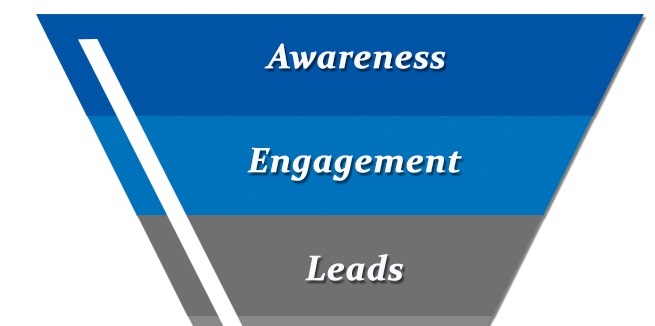In my last post, I shared with you why social media efforts often fall flat – in short, people are focused on the wrong things. This is not intentional, of course. Social media marketing is still widely misunderstood. It’s my hope to provide clarity to this confusion.
I have identified three primary objectives to meet an end goal of ‘sales,’ which ultimately consists of three objectives: awareness, engagement and lead generation.
You may be wondering how to fulfill those objectives using social media.
This post can be used as a short guide to help set goals for each objective, the measurables or Key Performance Metrics (KPI’s) associated with the goals and content suggestions that have worked for our clients to achieve positive ROI. Please keep in mind that these are general guidelines. Each business will need to determine the most effective goals to fulfill these objectives, and measurement will vary by channel. Also, this is just a sampling. There are dozens of goals you could set – and, some will overlap. For example, engagement such as post comments can also fulfill the awareness objective by resulting in higher reach and following.
Goals, KPI’s and Content – Oh My!
Objective: Awareness
Goal: Reach
KPI: The number of people who viewed a post
Content suggestions: Humanizing posts, tagging other pages (appropriately, such as sharing content and giving the author credit) and content shared by others can help to increase reach. On a medium like Facebook, some use paid advertising options such as an awareness ad or a post boost (considered engagement by Facebook) to help expand their reach.
Goal: Fans/Followers
KPI: The number of followers on a channel
Content suggestions: Using the above tactics are a good start for this metric as some may follow the business as a result of the reach. Again, a paid ad can accompany this effort, particularly when starting out.
Other measurables: Impressions, volume, and share of voice.
Objective: Engagement
Goal: Post reactions and comments
KPI: The number of reactions or ‘like’ as well as comments on a newsfeed post
Content suggestions: Open-ended questions, write the caption or finish the sentence posts often solicit comments.
Goal: Website clicks
KPI: The number of people who clicked a website link from social media – this can be tracked by most social sites and analyzed further in Google analytics
Content suggestions: Content that’s engaging will result in a click. This is usually made up of an intriguing headline or the combination of a headline and the caption accompanying the post, which entices the user to want to read more.
Goal: Increased length of time on website
KPI: The length of time a visitor from social media stays on the page they clicked – this can be tracked in Google Analytics
Content suggestions: Once we have the initial click (from the previous goal), we want the user to stay and read the post. It’s vital that the content is relevant to the headline or copy clicked and not ‘click bait’ that will lead the user to leave the page quickly.
Other goals/measurables could include online mentions, positive reviews, direct messages, and social shares.
Objective: Leads
Goal: Take action on a website (Ex: e-book download)
KPI: The number of people who took action on a website as a result of an initial click from social media. This can be tracked in Google analytics through behavior and user flow, UTM codes and other custom variables.
Content suggestions: When we get to this metric, it depends on the success of the other two engagement metrics (website clicks and length of time on pages). Often, if the content met the needs of the audience, they will naturally click to other pages on the website. A clear Call-to-Action (CTA) at the end of a post is helpful for encouraging that next step. For example, one of our clients invites his readers to take a deep dive into the topic by downloading a copy of his e-book at the end of his blog posts.
Goal: Online inquiry
KPI: The number of people who completed a ‘contact us’ form or other lead generation method
Content suggestions: This is where it gets tricky as how they found you, besides already being on site, could come from a number of factors such as Google search or a referral from another website. The best advice I can offer is to diversify your marketing and leads beyond social media. It’s now proven that Google algorithms favor brand signals as part of their search results. A ‘brand query’ is one type of brand signal, which are people who search for your business on Google. Brand query is a result of heightened brand awareness – our first objective. (Stay tuned for a future post on this topic).
Other goals/measurables could include a phone call or email inquiry, if we can effectively track the role of social media in the generation of that lead.
Based on the outcome of the last objective, it’s evident this is a cyclic process. It’s an ongoing effort and a good reminder that marketing shouldn’t stop once the lead is acquired. If relationship marketing is done well, a business can build customers for life.

